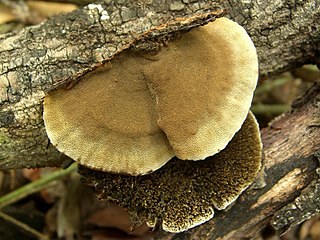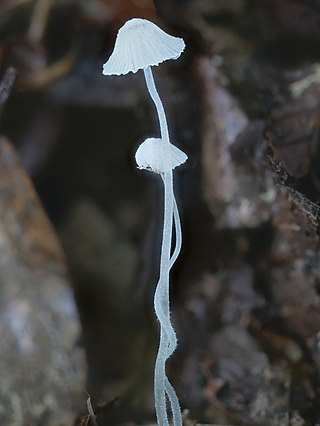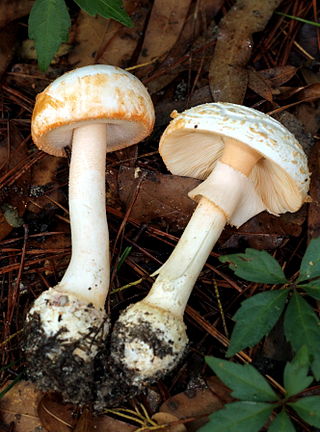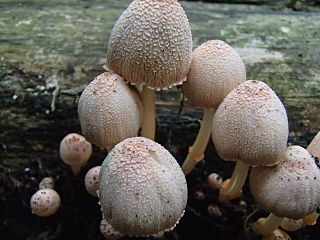
Lepiota is a genus of gilled mushrooms in the family Agaricaceae. All Lepiota species are ground-dwelling saprotrophs with a preference for rich, calcareous soils. Basidiocarps are agaricoid with whitish spores, typically with scaly caps and a ring on the stipe. Around 400 species of Lepiota are currently recognized worldwide. Many species are poisonous, some lethally so.

Limacella is a genus of mushroom-forming fungi in the family Amanitaceae in order Agaricales. Some of the species have been classified as members of genus Lepiota. Limacella was described by mycologist Franklin Sumner Earle in 1909.

The Polyporaceae are a family of poroid fungi belonging to the Basidiomycota. The flesh of their fruit bodies varies from soft to very tough. Most members of this family have their hymenium in vertical pores on the underside of the caps, but some of them have gills or gill-like structures. Many species are brackets, but others have a definite stipe – for example, Polyporus badius.

Hexagonia is a genus of poroid fungi in the family Polyporaceae. The genus has a widespread distribution, especially in tropical regions. The generic name is derived from the Latin word hexagonus, meaning "with six angles".

Lenzites is a widespread genus of wood-decay fungi in the family Polyporaceae. It was circumscribed by Elias Magnus Fries in 1835. The generic name honours German naturalist Harald Othmar Lenz (1798–1870).

Poronidulus is a fungal genus in the family Polyporaceae. It is a monotypic genus, and contains the single polypore species Poronidulus conchifer, found in North America. The genus was circumscribed by American mycologist William Alphonso Murrill in 1904. The generic name, which combines the Ancient Greek word πόρος ("pore") with the Latin word nidulus, refers to the superficial similarity of the cup-shaped Poronidulus fruit bodies with those of the genus Nidularia. A second species, Poronidulus bivalvis, found in Bogor, was placed in the genus by Franz Xaver Rudolf von Höhnel in 1914. The actual identity of this taxon, however, is uncertain.
Andrew Price Morgan was an American botanist. He investigated the flora of the Miami Valley in Ohio. While his interest included flowering plants, as noted by his Flora of the Miami Valley, Ohio, his special interest was in fungi. Morgan worked as a teacher in Dayton. He studied the botany of the Great Miami River, publishing in 1878 the Flora of the Miami River, Ohio; Morgan also showed particular interest in mycology and bryology. A.P. Morgan was a mentor to the prominent American mycologist Curtis Gates Lloyd. His correspondence with Lloyd is stored in the Lloyd Library and Museum in Cincinnati. Lloyds portion of the correspondence is stored in the Ada Hayden Herbarium at Iowa state university. Morgans collection of preserved fungi can also be found at the Ada Hayden Herbarium along with Laura Morgans gouache illustrations of fungi that could not be preserved.

Leucocoprinus fragilissimus, commonly known as the fragile dapperling, is a species of gilled mushroom in the family Agaricaceae.

Lepiota castaneidisca is a species of agaric fungus in the family Agaricaceae. Formally described in 1912, it was for a long time considered the same species as the similar Lepiota cristata until molecular analysis reported in 2001 demonstrated that it was genetically distinct. It is most common in coastal and northern California, and has also been recorded in Mexico. A saprobic species, it is usually found under redwood and Monterey cypress. Its fruit bodies (mushrooms) have white caps with an orange-red to orange-brown center that measure up to 3.2 cm (1.3 in) wide. The cream-colored to light pink stems are up to 6.5 cm (2.6 in) long by 0.2–0.6 cm (0.1–0.2 in) thick, and have a ring. L. castaneidisca can be distinguished from other similar Lepiota species by differences in habitat, macroscopic, or microscopic characteristics.

Tricholoma subresplendens is a mushroom of the agaric genus Tricholoma. It was first described by American mycologist William Alphonso Murrill in 1914.

Mycena alphitophora is a species of agaric fungus in the family Mycenaceae. Its small, white, delicate fruit bodies are characterized by the powdery coatings on the surfaces of both the cap and stipe. The stipe base is not swollen or disk-like. The stipe surface is more hairy than Mycena adscendens.

Chlorophyllum hortense is a species of agaric fungus in the family Agaricaceae.

Amanita roseotincta is a species of agaric fungus in the family Amanitaceae found in North America. It was first described by American mycologist William Alphonso Murrill in 1914 as a species of Venenarius before being transferred to Amanita the same year.

Coprinopsis mexicana is a species of fungus in the family Psathyrellaceae. Originally described in 1918 as Coprinus mexicanus by American mycologist William Alphonso Murrill, it was transferred to Coprinopsis in 2001.
Leucocoprinus flavescens is a species of mushroom-producing fungus in the family Agaricaceae.
Leucocoprinus muticolor is a species of mushroom producing fungus in the family Agaricaceae.
Leucocoprinus velutipes is a species of mushroom producing fungus in the family Agaricaceae.
Leucocoprinus minimus is a species of mushroom-producing fungus in the family Agaricaceae.













